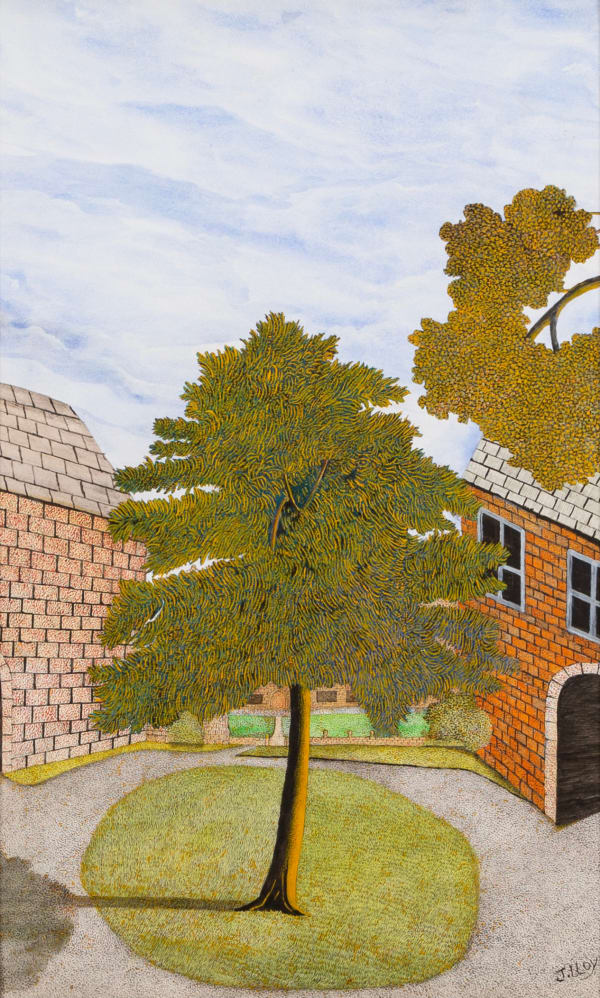James Lloyd 1905-1974
Lloyd was born in Alsager, Cheshire, the son of a policeman who had taken up farming. He had worked on his father's farm until the age of 19, when he too joined the police force. Lloyd had a variety of jobs before the war: gas-works stoker; bus conductor; builder's labourer; lamp-lighter; until he was accepted for the famous and exclusive British Army regiment of the Coldstream Guards. He served with distinction in his regiment overseas during the war. On demobilisation he married Nancy, she was a teenager and he in his forties, he returned to the land and took a job as - a wagonner- in Shropshire. He, his wife and four children bought a small holdings at Triangle, near Halifax, in the Pennines.
Although he had done some paintings as a young man, it was not until he was forty, that he began to paint in earnest. He and his family moved to Skirpenbeck, East Riding of Yorkshire in 1950. He took on the job as a cowman and painted by night at the kitchen table. Lloyd began to produce so many paintings - laboriously constructed, dot-by-dot, in their naîve pointillism - that his wife Nancy, who was his severest critic, decided it was time that Jim's work was seen by a wider public than his family. Without telling Jim, she wrote to Sir Herbert Read, who paid the artist a visit and left with a couple of new purchases. Read also borrowed some to send to show to a group of London galleries. In 1958, at the age of fifty-three, James held his first one-man show at Arthur Jeffress Gallery. All but two of the 32 paintings were quickly sold.
The rapidly expanding Lloyd family (eight children, and one who died young) moved to a council house further into the village and Jim took a job with the Derwent Plastics Company at Stamford Bridge, the money was better and the hours easier, he did shift work so he could paint by day and work by night. He devoted all his spare time (except for that spent at the pub) to painting. He never painted in a studio; he would usually just paint at the kitchen table or in the living room with the children playing around him. By the early 1960s he had stopped working at the Derwent Plastics factory to paint full-time.
In 1961 he was commissioned by the York City Art Gallery under the Evelyn Award Scheme to paint the view of Cliffords Tower, York for the gallery's collection - his first work in a public collection. L.S. Lowry also produced a painting of Cliffords Tower. He never titled his work, leaving his imaginative scenes open to the interpretation of the viewer.
At the closure of Arthur Jeffress Gallery, James Lloyd was taken on by the Portal Gallery, where his paintings still remain. His first one man show there was in 1964 followed by others in 1966, 1968 and 1971. He never titled or dated his paintings. In 1963 Eric Lister of the Portal Gallery introduced James to film director Ken Russell. The result was that the BBC Monitor unit made a television documentary film about his life and work, 'The dotty world of James Lloyd'. Two years later Lloyd was chosen to play - with no previous acting experience - the part of Henri Rousseau in Ken Russell's 'Monitor' film on the great French naîve painter.
The photographer, David Bailey, bought several paintings by Lloyd and became a very good friend. When his book 'Goodbye Baby and Amen', an album of Bailey's portraits of celebrities of the 60's was published, Jim featured prominently.
Other galleries who acquired his work were Leeds City Art Gallery, Bowes Museum; Thomas's College, York; and the Tate. He was also noticed by collectors abroad and his work was collected by museums as far apart as Caracas, Venezuela, and Zacreb, Yugoslavia. He won the coveted International Best Primitive Painter Award in 1973, with his painting 'Boy with Horse'.


